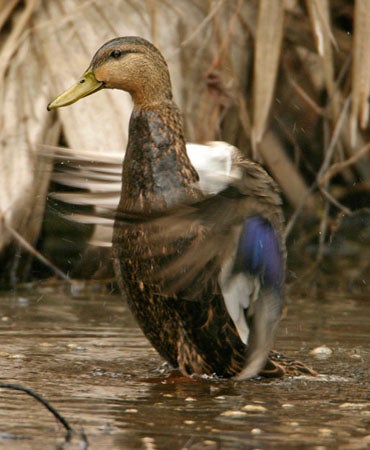SCIENTIFIC NAME:
Anas fulvigula
STATUS:
Breeder. Fairly common in spring, summer, and fall, and uncommon in winter in Gulf Coast region (mostly Mobile County). HIGH CONSERVATION CONCERN.
DESCRIPTION:
Mottled ducks (Anas fulvigula) are large brown ducks that appear very dark at a distance. Mottled ducks are darker than hen mallards but slightly lighter in color than black ducks. The mottled duck’s neck and head are lighter in color than the adjoining back and breast area, a pattern not seen in black ducks or hen mallards. Male and female mottled ducks are almost identical in appearance, but they can be distinguished by bill coloration. Males have a bright yellow to olive bill with a black spot at the base, while females have a dull orange bill with black blotches. The speculum of the mottled ducks is a more greenish hue than that of mallards or black ducks. A narrow, white edging usually is present on the trailing edge of the speculum and is rarely present on the leading edge.
DISTRIBUTION:
The mottled duck’s annual life cycle is spent entirely in a narrow band of marsh habitat along the Gulf Coast stretching from south Texas, Louisiana, Mississippi, and Alabama, to the southern tip of the Florida peninsula..
HABITAT:
The mottled duck’s breeding and wintering ranges are identical. A major reason for the continued existence of the mottled duck in substantial numbers is that the bird occupies a wide and diverse breeding and winter range. These habitats can be categorized into three types: rice production and cattle pasture in coastal Louisiana; cattle pasture, shallow bay and citrus farm region, and coastal marsh in the Laguna Madre region in south Texas; and coastal marsh, is interspersed among the other two types – the only habitat type found in the costal regions of Mississippi and Alabama.
FEEDING HABITS:
The nutritional composition of the mottled duck’s diet, varies during different stages of its life cycle. Ducklings, just after leaving the nest, feed heavily on invertebrates such as scuds and midge larvae. At about three weeks of age, the mottled duck ducklings begin to ingest an increasing percentage of seed and plant material. Because these ducklings are flightless at this time in their life, their food intake is controlled primarily by the availability of food. Animal materials make up about 12 percent of their diet with the remaining 88 percent being made up of plant materials such as seeds. The percentage of plant material found in the mottled duck diet increases as the ducklings grow, reaching to over 99 percent plant material as adults.
LIFE HISTORY AND ECOLOGY:
The mottled duck is one of three species of duck that are found in Alabama year-round. Unlike the other two species, wood duck and mergansers, that do have some portion of their population that migrate to breeding ground in the in the northern United States and Canada.
The mottled duck is a close relative to the more widely dispersed mallard. This close relationship with the mallard is evident with their very similar looks and vocalization.
The female will construct a slightly elevated nest in the marsh grasses, sometimes up to a half-mile from water, and will lay 3 to12 olive green eggs. Incubation is completed by the female, usually in 22 to 25 days. Unlike many other waterfowl species, the male will stay in the vicinity of the nest and may offer help in raising the young. The ducklings will fledge in 36 to 57 days.
REFERENCES:
Alsop, F. 2001.Birds of North America. DK Publishing Inc., New York, NY.
Carney, Samuel M.1992. Species, Age and Sex Identification of Ducks Using Wing Plumage. U.S. Department of the Interior, U.S. Fish and Wildlife Service. 144pp.
Author:
Ben Davis






